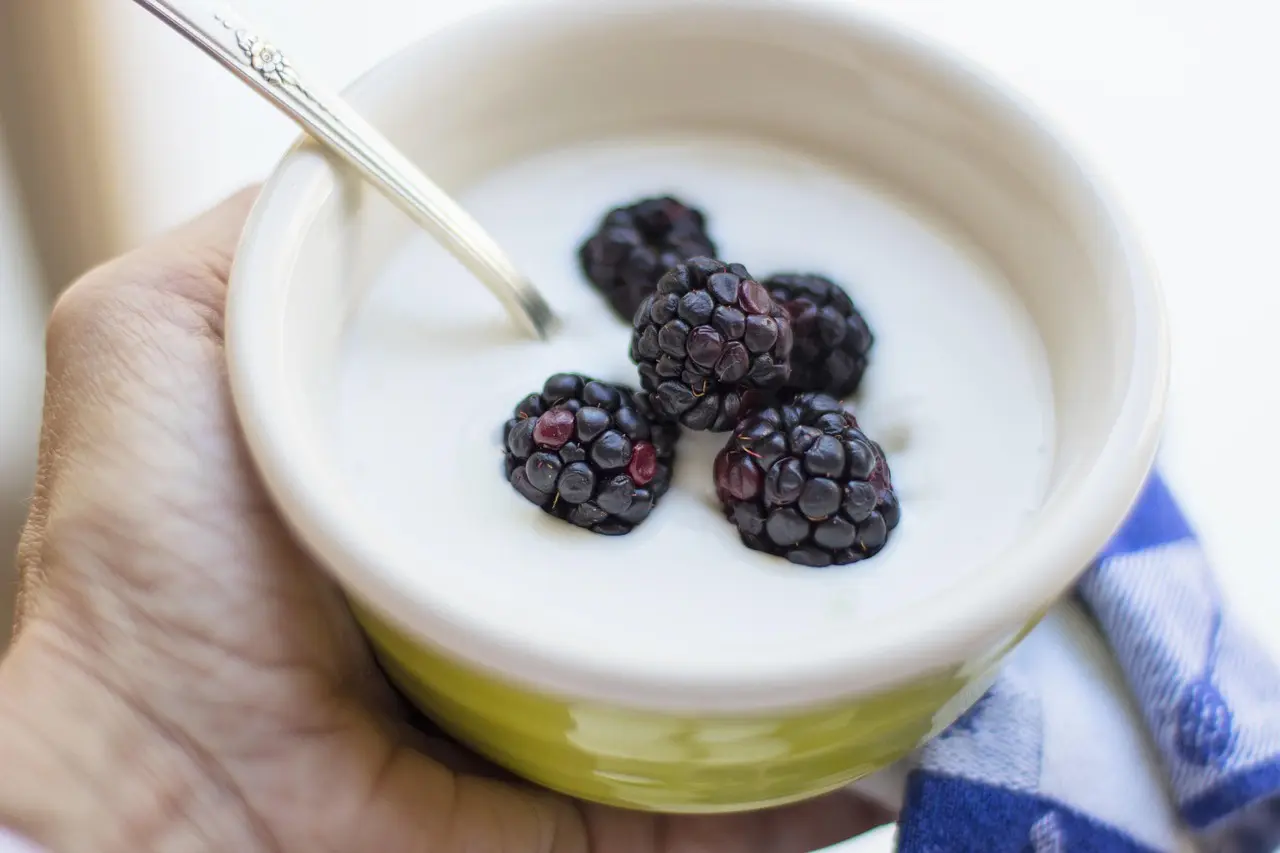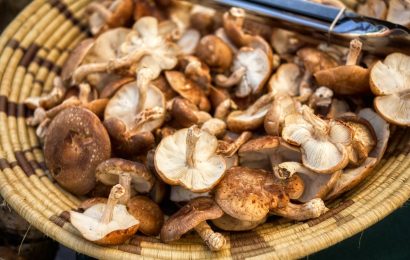Scientists have been quietly changing the rules about how much protein women over 40 really need – and most of us haven’t caught up yet. Here’s what new research says about getting it right.
Let’s be honest: nutrition advice gets louder the moment your 40s roll around. Suddenly, you’re hearing about metabolism, muscle, bone health, and “get 30 grams of protein at breakfast!” Should you actually do that – or is it just another trend?
Here’s the simple, practical truth backed by solid research and clinical guidelines: the classic 0.8 g/kg/day number you grew up with is a minimum for healthy adults, not an “optimal” target for women in midlife. As muscle becomes a little harder to maintain (hello, anabolic resistance) and menopause changes the playing field, most women 40+ need to make some changes.
ID 15253542 ©Monkey Business Images | Dreamstime.com
I am writing this article as I wanted to learn more about this topic – and asked my doctor too – because over the last few years I felt more and more the need to increase my protein intake (I prefer meat). So my body was already trying to tell me that some changes are in order.
I am also advising you to take this article as informational only and to only make changes after talking with your doctor. I am sharing what I discovered and what I learned from different studies available.
Why protein starts to matter more in your 40s (and beyond)
Think of your muscles like email inboxes. At 25, they “open” and respond to small protein messages quickly. As you age, the “inbox” gets picky – you need a clearer, louder signal (i.e., a larger protein dose with enough leucine) to trigger the same muscle-building response. That’s anabolic resistance in a nutshell.
Two high-quality consensus documents capture the shift:
- ESPEN geriatrics guidance: ensure ≥1.0 g/kg/day for older adults; consider higher intakes when you’re active, ill, or rebuilding after injury.
- PROT-AGE position paper: recommends ~1.0–1.2 g/kg/day for maintaining or regaining lean mass and function, with higher intakes when training or during illness.
Simply said: the RDA prevents deficiency; your 40s+ need a little more to feel and function your best. (European Food Safety Authority)
So… how much protein should you eat?
Use your current healthy body weight (or a clinician-advised target) and multiply:
- Most healthy women 40+: 1.0–1.2 g/kg/day
- Active / lift weights / in a fat-loss phase: ~1.2–1.6 g/kg/day (adjust to total calories)
- Illness, recovery, frailty: often toward the upper end under professional guidance
- Chronic kidney disease (CKD): different rules (see the safety note below)
Caution: these are numbers from the studies. Talk to your doctor before making any change.
Examples (just to visualize):
- 65 kg (143 lb) → 65–78 g/day (1.0–1.2 g/kg); up to ~104 g at 1.6 g/kg
- 75 kg (165 lb) → 75–90 g/day; up to ~120 g at 1.6 g/kg
These ranges align with expert groups focused on healthy aging, not just basic prevention.
The “how” matters: per-meal targets & the leucine trigger
Here’s where many women get stuck: you hit your total grams by night – but still struggle with strength and energy. That’s because protein works best when you spread it across the day and hit a meaningful dose at each meal.
- Aim for ~25–35 g protein per main meal (roughly ~0.4 g/kg/meal for many women).
- That usually delivers ~2.5–3 g leucine, the amino acid that flips the “muscle protein synthesis” switch (your body’s repair/build signal).
- Even distribution across breakfast, lunch, and dinner outperforms a single big protein dinner in stimulating 24-hour muscle protein synthesis. (PubMed Central)
Recent reviews reinforce that older adults often need ~30 g protein (and ~2.8–3 g leucine) in a meal to fully activate that muscle-building response. (PubMed Central)
What about workouts? Have one of those “25–35 g meals” within a few hours after resistance training to support recovery and adaptation. The daily total matters most, but this is an easy win. (Frontiers)
Why women over 40 benefit from this upgrade
ID 166573746 ©Monkey Business Images | Dreamstime.com
1) Lean mass, strength, and everyday energy
Getting enough total protein – and enough per meal – helps you keep (and even build) lean mass and strength as hormones shift. Studies show higher protein intakes bolster muscle outcomes, especially when paired with resistance training. (ESPN cited above)
2) Better weight-loss quality (more fat loss, less muscle loss)
During calorie deficits, higher-protein diets protect muscle while you’re losing fat – critical for metabolism and long-term weight maintenance. This holds true in postmenopausal women and older adults. (PubMed Central)
I can confirm that you can lose weight – healthy! – by eating more protein.
3) Bone health support (with the right “team-mates”)
Protein provides the scaffolding for bone (collagen matrix) and supports the muscles that load your skeleton. Systematic reviews/meta-analyses suggest intakes above the RDA can help maintain bone mineral density and may reduce hip fracture risk – as long as you also meet calcium and vitamin D needs and do weight-bearing or resistance exercise. (PubMed)
Per my doctor’s advice, I ran baseline blood tests and waited for the results before changing my diet or supplements.
(If you spotted older claims that “protein leaches calcium,” the more current big-picture evidence paints a nuanced but generally positive role for adequate protein in bone – especially alongside minerals and training. PubMed Central)
What 25–35 g of protein looks like (real-world plates)
Use these as mix-and-match building blocks. For exact numbers, check USDA FoodData Central when planning (there are other sources online).
Animal-based (approximate):
- 100 g cooked chicken/turkey breast → ~30–32 g
- 120–150 g cooked salmon/tuna/cod → ~26–35 g
- 170 g (6 oz) Greek yogurt → ~17–20 g (add a scoop whey to reach 30+)
- 2 large eggs + 60 g egg whites → ~20–24 g
- 150 g cottage cheese → ~20–25 g
Plant-forward (approximate):
- 200 g firm tofu → ~22–24 g (add edamame or quinoa to hit 30+)
- 1 cup cooked lentils → ~18 g (pair with ½ cup quinoa or tofu)
- 1 cup chickpeas → ~14–15 g (pair with whole-grain pita + tahini)
- 2 tbsp peanut butter + 2 slices whole-grain bread → ~14–16 g (add a cup of soy milk to reach 25–30 g)
Leucine tip: Dairy, eggs, fish, poultry, lean meats, and soy are naturally leucine-rich. Hitting ~25–35 g of high-quality protein per meal usually covers the ~2.5–3 g leucine “trigger.” (MDPI)
A day that checks the boxes (example for a 75-kg woman)
- Breakfast (~30–35 g): Greek yogurt bowl (yogurt + high-protein granola + chia) or tofu scramble with black beans + whole-grain toast.
- Lunch (~30–35 g): Salmon salad bowl (120–150 g cooked salmon) with farro; or lentil-quinoa bowl with tahini.
- Dinner (~30–35 g): Chicken stir-fry (100–120 g chicken) with edamame and brown rice; or tempeh fajitas with black beans.
- Optional snack (10–20 g): Cottage cheese + berries; roasted edamame; a soy- or whey-based smoothie.
Even distribution? Check. Leucine threshold? Check. Tasty? Also check. (PubMed)
Plant-based and thriving: yes, you can
You don’t need animal protein to hit your targets. The Academy of Nutrition and Dietetics confirms that well-planned vegetarian and vegan diets can meet protein and amino-acid needs across all life stages.
Focus on total daily grams and include soy foods (tofu, tempeh, edamame, soy milk), legumes, whole grains, nuts/seeds—and you’re golden. (There’s also a brand-new 2025 position paper reaffirming adequacy for adults.)
Protein & menopause: what recent research says
- Whey + strength training helps: In postmenopausal women, whey protein supplementation enhances body composition and lean mass – but mainly when paired with resistance training. Without training, whey alone doesn’t move the needle much. Translation: the magic is the combo. (PubMed Central)
- Higher protein during weight loss protects muscle: Studies in postmenopausal women show less lean-mass loss and better outcomes when protein is dialed up during calorie deficits. (PubMed Central)
- Distribution still matters: Spreading protein across meals improves 24-hour muscle protein synthesis compared with “protein-bombing” at dinner. (see the above-cited article on this topic)
Bone health: connect the dots (protein + minerals + training)
Think of bone like a skyscraper: protein forms the scaffolding; calcium and vitamin D supply the concrete; resistance/impact exercise tells your body to keep building.
Meta-analyses suggest protein intakes above RDA can help maintain bone mineral density and reduce hip fracture risk in older adults – especially in the context of adequate calcium/vitamin D and strength/weight-bearing exercise. (PubMed)
There are isolated findings hinting at potential negatives of very high protein on bone in inactive postmenopausal women – but those effects tend to disappear (or flip positive) when exercise is in the mix. Movement matters. (MDPI)
Safety first: who shouldn’t crank up protein without medical advice?
Chronic Kidney Disease (CKD): Bottom line: If you have diagnosed kidney disease – or even a hint of reduced kidney function – talk to your nephrologist/dietitian before changing protein.
Liver disease, uncontrolled diabetes, GI disorders, recent surgery/illness: individual prescriptions vary – get personalized guidance.
Supplements: whole foods first. If you do use powders, choose reputable brands (third-party tested) and count them toward your daily total.
General disclaimer:
This article is informational only and NOT medical advice. If you have any medical condition, are on medication, or have a history of kidney disease, get individualized recommendations from your healthcare provider or a registered dietitian.
Protein-rich foods & smart combos (super practical list)
Leucine-rich “heavy hitters”: Greek yogurt, cottage cheese, milk, whey; eggs; fish/seafood; poultry; lean beef; soy (tofu, tempeh, edamame, soy milk). (MDPI)
Plant combos you’ll actually eat (confirm these with your dietician first!):
- Lentils + quinoa + tahini bowl
- Chickpeas + whole-grain pita + hummus + salad
- Black beans + brown rice + avocado burrito bowl
- Tofu + edamame + soba stir-fry
Snacks (10–20 g): Cottage cheese + berries; protein smoothie (soy or whey) with fruit; roasted edamame; hummus + whole-grain crackers + hemp seeds.
Nerd-friendly detail: Use USDA FoodData Central to check exact protein grams for your favorite foods or brands.
Put it into action this week (no perfection required)
Pick a daily target
Most women 40+: 1.0–1.2 g/kg/day
Active or in a fat-loss phase: up to ~1.6 g/kg/day if healthy.
Hit a real dose at each meal
~25–35 g (≈0.4 g/kg/meal) to reach the leucine trigger.
PubMed Central
Lift something
2–3×/week resistance training is the multiplier for muscle and bone benefits.
Mind the bone trio
Protein + calcium + vitamin D + weight-bearing/resistance exercise = best odds for strong bones.
Personalize if you have medical conditions
I am recommending you to read these articles too – for more ways that are EASY to implement and can make your life better (and longer):
- Scientists Reveal the Unexpected Longevity Habit That Costs Nothing
- Scientists Say This Overlooked Habit Could Add Years to Your Life
- Scientists Say People With This Mindset Are Far More Likely to Reach Age 90+
- Add Decades, Not Just Years: 8 Habits That Could Add 20–25 Years to Your Life (Backed by a Massive Study)
- Want a Longer, Happier Life? Scientists Say This 1-Hour Habit Could Be the Key
- Want to Live Longer? Studies Say These Mental Habits May Help (No Sweat Required)
- Eat Earlier, Live Longer? What a New Study Says About Breakfast Timing, Aging, and Longevity
- Simple daily habits for a healthier mind
- How to De-Clutter Your Mind, Backed by Science
- The Personality Traits That Can Help You Live Longer (and Be Happier)
- How to Build Real Self-Esteem That Lasts (Backed by Science, Not Buzzwords)
- 17 Signs You Are Happier Than You Think
- 11 Signs You Are More Intelligent Than You Think
- Things People With High Self-Esteem Rarely Do
- How to Reduce Sugar Intake Naturally
- Science-Backed Benefits of Eating Walnuts (and How Much You Should Actually Eat)
- Things I Didn’t Expect to Happen When I Turned 40 (But Totally Did)
- 15 Signs You’re More Emotionally Intelligent Than You Think – Backed by Science
Protein for Women Over 40: Frequently Asked Questions
How much protein should women over 40 eat each day?
Most healthy women 40+ do well around 1.0–1.2 g/kg/day; active women or those in a fat-loss phase may benefit from ~1.2–1.6 g/kg/day, assuming normal kidney function.
How do I calculate my personal protein target?
Multiply your current healthy body weight in kilograms by your chosen factor (e.g., 1.2). A 75-kg woman × 1.2 ≈ 90 g/day.
Is 0.8 g/kg/day enough after 40?
That’s the RDA – a minimum to prevent deficiency for average adults. Many experts suggest higher intakes in midlife to better support muscle function.
How much protein should I eat per meal?
Aim for ~25–35 g at each main meal (roughly 0.4 g/kg/meal for many women). That typically supplies ~2.5–3 g leucine, the “on” switch for muscle protein synthesis.
Do I need animal protein, or can I hit my goals plant-based?
You can absolutely meet needs on a well-planned vegetarian or vegan diet – lean on soy (tofu, tempeh, edamame), legumes, whole grains, nuts/seeds.
What are quick ways to hit ~30 g at breakfast?
Greek yogurt + whey; tofu scramble with black beans; eggs + egg whites plus a cup of soy milk; cottage cheese bowl with high-protein granola.
Does protein timing matter if I work out?
Total daily intake is king, but having one of those 25–35 g meals within a few hours after lifting supports recovery and adaptation.
Will higher protein help during weight loss?
Yes – higher protein during a calorie deficit helps preserve lean mass and can improve body-composition outcomes (especially paired with resistance training).
Is more protein better for bone health?
Adequate protein supports the bone matrix and the muscles that load bone; pair it with calcium, vitamin D, and resistance/weight-bearing exercise for best results.
How much is “too much” protein?
For healthy adults, benefits generally plateau around ~1.6 g/kg/day. Going higher isn’t usually necessary—and if you have kidney disease, follow medical guidance.
Is protein powder necessary – or safe?
Not required, but convenient. Choose reputable, third-party-tested products (whey or soy), and count them toward your daily total. Whole foods first.
I have chronic kidney disease. Should I increase protein?
No – don’t change intake without medical advice. CKD often calls for ~0.8 g/kg/day (non-dialysis) and avoiding high intakes; your nephrologist/dietitian should set your target.
Can intermittent fasting work with higher protein?
Yes, but fit two to three ~25–35 g doses into your eating window so you still hit per-meal thresholds.
Do I need a leucine supplement?
Usually no. Hitting ~25–35 g of high-quality protein per meal provides ~2.5–3 g leucine naturally (dairy, eggs, fish, poultry, soy).
What’s a simple daily template to follow?
Three main meals at ~25–35 g each, plus an optional 10–20 g snack, and 2–3 strength sessions per week.
Photo sources (apart from Dreamstime): 1, 2







